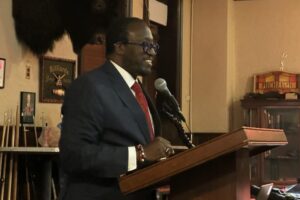As the Public Schools of the Tarrytowns search for ways to balance the books amidst the current economic recession, without imparting an inordinately large tax increase on the Villages of Tarrytown and Sleepy Hollow, no cost-cutting idea is being ignored − including the possible closing of either Tappan Hill or John Paulding.
 To understand why the District would consider closing a school, it’s important to understand the financial issues driving the conversation. According to Superintendent Howard Smith, the District’s capacity to support budget increases is currently limited to property tax dollars only. All other avenues of funding have simply dried up, including funds the District counts on from the State of New York. “Ordinarily we get a certain amount of money from the State,” says Dr. Smith. “But at this point they’re up there contemplating cutting state aid for us this mid-year, even relative to what they promised us. The Governor’s proposal was to reduce the aid that they promised us for this year by $700,000. And if they don’t cut it this year, we fully expect them to cut it next year. They’re broke.”
To understand why the District would consider closing a school, it’s important to understand the financial issues driving the conversation. According to Superintendent Howard Smith, the District’s capacity to support budget increases is currently limited to property tax dollars only. All other avenues of funding have simply dried up, including funds the District counts on from the State of New York. “Ordinarily we get a certain amount of money from the State,” says Dr. Smith. “But at this point they’re up there contemplating cutting state aid for us this mid-year, even relative to what they promised us. The Governor’s proposal was to reduce the aid that they promised us for this year by $700,000. And if they don’t cut it this year, we fully expect them to cut it next year. They’re broke.”
If that weren’t bad enough, much of what the State is able to send to the District is currently being fed by money from the federal stimulus package, and that money − over $1,500,000/year − runs out after the 2010/2011 school year. So the budget woes may just be beginning.
On the other end of the balance sheet, costs are rising for the District as well. Utility rates are climbing, health insurance costs are expanding, and the District is facing (along with every other school district in the state), a 50 percent increase in retirement contribution expenses. Dr. Smith tries to put the District’s position in perspective. “Just to take this budget and roll it forward, status quo, and do business exactly the same another year would require a 12% [tax] increase.” He emphasizes, however, that nobody is seriously contemplating such a dramatic increase. As far as he’s concerned, that’s already off the table. “There’s no scenario under which we’ll bring a budget out there with a 12% [tax] increase. But that means, by definition, you cannot do business as usual next year; something’s got to give. And that’s what’s driving this.”
One of the most dramatic cost-saving measures being looked at is closing either Tappan Hill or John Paulding school. When the 6th grade was moved from the Washington Irving School to Sleepy Hollow Middle School, it created, potentially, a grade level of surplus space in its wake. It is this available space that spurs talk of building closure. “If we moved the 3rd Grade to Washington Irving, and then moved 1st grade to Morse,” explains Smith, “we could either vacate the current Kindergarten school and move Kindergarten to Paulding, or vacate Paulding and leave the Kindergarteners where they are.”
Not everyone involved in the decision-making process feels that this is a realistic scenario. Kim DeRosario Fonseca, a teacher at John Paulding, put it simply. “Morse, being Morse, is really not appropriate for first graders.” She points out that both Morse and Washington Irving were at one time high schools, and that the buildings simply weren’t created with elementary school-aged children in mind. Having taught there herself for many years, she says, “Morse is a maze.Children get lost in there now.”
Washington Irving Principal, Bill Greene, was more upbeat about the possibility. He acknowledged that Washington Irving would have to make some sacrifices were it to once again house three separate grades, but said that only “minor alterations” would be needed. The consequences would be that some programs, such as the Spanish language program or the music program, would have to be taught from a mobile cart rather in their own classrooms. “We’re currently enjoying lots of space with everyone having their own room,” he says, “and that would no longer be the case.”
To determine the viability of such a scenario, the District took a close look at the financial numbers involved. The preliminary results were not something that could be ignored. “Right now we’re looking at potential savings [for the first year] of somewhere in the mid-$300,000 range — about $370,000. That’s a preliminary figure,” says Dr. Smith. “The long-term savings might be over $400,000 [per year].” These numbers do not represent a final figure, but are intended to give the District a ballpark estimate. Another thing they learned is that the amount saved ended up being roughly the same no matter which school is closed. Dr. Smith is quick to point out, however, that these numbers don’t take into account any additional revenue the District might realize by leasing out whichever property they were to close down.
An additional wrinkle in all of this is the physical status of both Tappan Hill and John Paulding. While there is no truth to the rumor that these changes are in some way being led by a need to get those buildings into compliance with State guidelines, both buildings, over the long haul, need a lot of upkeep. Says Dr. Smith, “If we’re going to stay in those buildings, we’re going to have to spend some money over time and it’s a question of how much.” The initial numbers are significant, with John Paulding needing over $250,000 in maintenance work, and Tappan Hill topping that with an estimated need of nearly $800,000, much of which is due to the modular structure currently used to house the Pre-K program. But Dr. Smith stresses that these needs are not immediate. “If it was a year or two, it would be OK; if it gets much longer than that, then we would have to either replace the modular building [at Tappan Hill] or get out.”
With so much at stake, the Board of Education asked for the creation of the Building Closure Study Committee. Facilitated by Dr. Smith, the committee consists of parent reps, staff reps, and people from the villages and school buildings. The committee has been tasked with looking at every issue associated with the possibility of closing one of the single-grade schools − either Tappan Hill or John Paulding. Explains John Paulding teacher and committee member, Cathy Chula, “We were asked to look at the plan as a whole and come up with pros and cons on how we thought this [the closing of one of the schools] would affect the District.”
The committee has not been tasked with coming up with recommendations, only with gathering all the information and presenting it to the Board who will, in the end, make the final decision. “We constantly have to look to make sure that we’re cost effective and that we are doing everything to maintain the highest level of education for the children in the community,” explains Mimi Godwin, President of the Board of Education. Chula reports that the John Paulding team came to some rather distressing conclusions with reference to the potential changes, stressing that Morse was originally built as a high school. “Children who are five cannot physically maneuver that building.” Relying on her thirteen years of teaching experience within the Morse building, she states, “The whole size of that building is inappropriate for a first grader.” In the end, she feels that the choice facing the District is relatively straightforward. “Are we willing to give up some of the charm and benefits that we have given our children to save money?”
John Paulding Principal, Marilyn Mercado-Belvin, another member of the committee, agrees that this is not a decision that can be made lightly. “Closing a building will have a major impact on all of the schools, “ she says via email. “The impact goes beyond financial implications. All of the elementary grades would be affected by the moves, and school cultures would be reinvented and redefined.”
In the face of such a dramatic change, Dr. Smith points out the obvious consequence of not finding a way to cut costs. “Ultimately, when we exhaust everything else, we start to lay off teachers,” he says. “Class sizes increase, the number of electives that we can offer is reduced, more kids get housed in study halls, it’s all bad.”
Aware of what a major impact this decision will have on both Villages, the Board of Education is attempting to make this process as public as possible. “It was very public from day one in terms of this being a goal we need to look at,” says Dr. Smith. In fact, once the committee makes its report, there will be public hearings on this topic. Hearings that, according to Godwin, the Board will make every effort to publicize above and beyond the usual listings online and in the Village Hall. “In a case like this,” she says, “we would make every effort to get the information out that this would be what we would be discussing, definitely.”
Most of the individual school teams have already put together their list of pros and cons surrounding the closing of one of the single-grade schools. Their reports were being gathered by Dr. Smith the first week of December, and an eventual presentation by Dr. Smith to the Board of Education will be made in February, to give the Board enough time to deliberate the matter before budgets are due in April. That is not to say that the matter is closed to comment from the public. In fact, Dr. Smith welcomes the public’s thoughts on the matter. “Anybody who wanted to have input in general, the quickest, easiest way is to send something to my attention via email.”
While nobody yet knows what the findings of the committee will be, the very real possibility remains that the Board of Education may, after reviewing the report, decide to close down either Tappan Hill or John Paulding as early as the coming 2010/2011 school year. Everyone we spoke with agreed that while this may not be a desirable outcome, it is certainly within the realm of possibility, and is entirely doable. “If something happened to Tappan Hill or John Paulding and we had to move out,” says Dr. Smith, “we could be up and running within a week.”
Mrs. Fonseca, however, worries that ultimately the District’s decision could become a financial one that doesn’t keep the children’s best interests at the forefront of the decision-making process. “Are we going to do what’s right for children,” she asks, “or are we only looking at money, even if it’s wrong for children?”
To be certain, everybody involved in this difficult decision would rather not have been forced into this corner like they have by the current financial environment. “We’ve come to a point… where we’re into some forced choices we’d really prefer not to be facing,” says Dr. Smith. “But, ultimately, if the only way you can bring in a reasonably defensible budget is through starting to take teachers away from kids − which [is] the most valuable commodity you have to offer kids, not the building, the teachers − if you’re taking teachers away from kids, you really have to take a serious look at alternatives. Folks need to ask themselves how many teachers would they would be willing to lay off to match the savings that we could achieve by [closing one of the schools], and is that worth it?”







